| [1]Gautier M, Eliot N.Extrahepatic biliary atresia. Morphological study of 98 biliary remnants.Arch Pathol Lab Med. 1981; 105(8):397-402.[2]Chardot C,Serinet MO.Prognosis of biliary atresia: what can be further improved? J Pediatr.2006;148(4):432-435.[3]Serinet MO,Wildhaber BE,Broué P,et al.Impact of Age at Kasai Operation on Its Results in Late Childhood and Adolescence: A Rational Basis for Biliary Atresia Screening. Pediatrics.2009;123(5):1280-1286.[4]Gillespie JR,Uversky VN.Structure and function of alpha-fetoprotein: a biophysical overview.Biochim Biophys Acta.2000;1480(1-2):41-56.[5]Blohm ME,Vesterling-Hörner D,Calaminus G,et al.Alpha 1-fetoprotein (AFP) reference values in infants up to 2 years of age.Pediatr Hematol Oncol.1998;15(2):135-142.[6]Ohama K,Nagase H,Ogino K,et al.Alpha-fetoprotein (AFP) levels in normal children.Eur J Pediatr Surg. 1997;7(5): 267-269.[7]Ball D, Rose E,Alpert E.Alpha-fetoprotein levels in normal adults.Am J Med Sci. 1992;303(3):157-159.[8]Li C,Zhang Z,Zhang P,et al.Diagnostic accuracy of des-gamma-carboxy prothrombin versus α-fetoprotein for hepatocellular carcinoma: A systematic review.Hepatol Res. 2015;44(10):E11-E25.[9]Willemse PH,Sleijfer DT,Schraffordt Koops H,et al.Tumor markers in patients with non-seminomatous germ cell tumors of the testis.Oncodev Biol Med.1981;2(1-2):117-128.[10]Talerman A,Haije WG,Baggerman L.Serum alphafetoprotein (AFP) in diagnosis and management of endodermal sinus (yolk sac) tumor and mixed germ cell tumor of the ovary. Cancer.1978;41(1):272.[11]Wu JT,Book L,Sudar K.Serum alpha fetoprotein (AFP) levels in normal infants.Pediatr Res.1981;15(1):50-52.[12]Kuhlmann WD, Wurster K.Correlation of histology and alpha 1-fetoprotein resurgence in rat liver regeneration after experimental injury by galactosamine.Virchows Arch A Pathol Anat Histol. 1980;387(1):47-57.[13]Woolbright BL,Jaeschke H.Therapeutic targets for cholestatic liver injury.Expert Opin Ther Targets. 2016;20(4):463-475.[14]Miyaoka Y,Ebato K,Kato H,et al.Hypertrophy and unconventional cell division of hepatocytes underlie liver regeneration.Curr Biol.2012;22(13):1166-1175. [15]Kamiya A,Inagaki Y.Stem and progenitor cell systems in liver development and regeneration.Hepatol Res. 2015;45(1): 29-37. [16]Lowes KN,Croager EJ,Olynyk JK,et al.Oval cell-mediated liver regeneration: Role of cytokines and growth factors.J Gastroenterol Hepatol.2003;18(1):4-12.[17]Miyajima A, Tanaka M, Itoh T.Stem/progenitor cells in liver development, homeostasis, regeneration, and reprogramming. Cell Stem Cell. 2014;14(5):561-574. [18]Furuyama K,Kawaguchi Y,Akiyama H,et al. Continuous cell supply from a Sox9-expressing progenitor zone in adult liver, exocrine pancreas and intestine.Nat Genet.2011;43(1):34-41.[19]Gouw AS,Clouston AD,Theise ND.Ductular reactions in human liver: diversity at the interface. Hepatology. 2011;54(5): 1853-1863.[20]Ruck P,Xiao JC,Kaiserling E.Small epithelial cells in extrahepatic biliary atresia: electron microscopic and immunoelectron microscopic findings suggest a close relationship to liver progenitor cells.Histopathology. 2010; 35(5):454-460.[21]Kakisaka K,Kataoka K,Onodera M,et al.Alpha‐fetoprotein: A biomarker for the recruitment of progenitor cells in the liver in patients with acute liver injury or failure.Hepatol Res. 2015; 45(10):570-571.[22]Caja L,Dituri F,Mancarella S,et al.TGF-β and the Tissue Microenvironment: Relevance in Fibrosis and Cancer.Int J Mol Sci.2018;19(5):1294.[23]Marra F,Romanelli RG,Giannini C,et al.Monocyte chemotactic protein‐1 as a chemoattractant for human hepatic stellate cells.Hepatology.1999;29(1):140-148.[24]Mavila N,James D,Shivakumar P,et al. Expansion of prominin-1-expressing cells in association with fibrosis of biliary atresia.Hepatology.2015;60(3):941-953.[25]Ramm GA, Shepherd RW, Hoskins AC,et al. Fibrogenesis in pediatric cholestatic liver disease: role of taurocholate and hepatocyte-derived monocyte chemotaxis protein-1 in hepatic stellate cell recruitment.Hepatology.2009;49(2):533-544.[26]Whitfield JB.Gamma glutamyl transferase.Crit Rev Clin Lab Sci. 2001;38(4):263-355.[27]Lum G, Gambino SR.Serum gamma-glutamyl transpeptidase activity as an indicator of disease of liver, pancreas, or bone. Clin Chem.1972;18(4):358-362.[28]Rendón-Macías ME,Villasís-Keever MA,Castañeda-Muciño G,et al.Improvement in accuracy of gamma-glutamyl transferase for differential diagnosis of biliary atresia by correlation with age.Turk J Pediatr.2008;50(3):253-259.[29]Zhang RZ,Yu JK,Peng J,et al.Role of CD56-expressing immature biliary epithelial cells in biliary atresia.World J Gastroenterol.2016;22(8):2545-2557. [30]Wenham PR, Price CP, Sammons HG.gamma-Glutamyl transferase isoenzymes in human bile.J Clin Pathol.1978; 31(7):666-670. |
.jpg) 文题释义:
胆道闭锁:是一种严重的新生儿肝胆外科疾病,特征为肝内或肝外胆管闭塞引发的黄疸和进行性肝纤维化,早期诊断和治疗对该病患儿的意义重大。但该疾病在病理特征上与新生儿肝炎相类似,目前只能通过腹腔探查等手术手段最终确诊,这些方法操作复杂且对患儿伤害较大,不适合早期诊断。因此寻找简单有效的生物标志物是胆道闭锁研究的重要内容。
甲胎蛋白:由肝脏合成,是血浆白蛋白的胎儿形式,在胎儿及新生儿血浆中含量丰富,在出生后1年内迅速下降至成人水平。甲胎蛋白的表达与肝细胞增殖或肝损伤后的再生过程有关,肝癌或其他类型的肝损伤将导致甲胎蛋白的表达量升高。
文题释义:
胆道闭锁:是一种严重的新生儿肝胆外科疾病,特征为肝内或肝外胆管闭塞引发的黄疸和进行性肝纤维化,早期诊断和治疗对该病患儿的意义重大。但该疾病在病理特征上与新生儿肝炎相类似,目前只能通过腹腔探查等手术手段最终确诊,这些方法操作复杂且对患儿伤害较大,不适合早期诊断。因此寻找简单有效的生物标志物是胆道闭锁研究的重要内容。
甲胎蛋白:由肝脏合成,是血浆白蛋白的胎儿形式,在胎儿及新生儿血浆中含量丰富,在出生后1年内迅速下降至成人水平。甲胎蛋白的表达与肝细胞增殖或肝损伤后的再生过程有关,肝癌或其他类型的肝损伤将导致甲胎蛋白的表达量升高。.jpg) 文题释义:
胆道闭锁:是一种严重的新生儿肝胆外科疾病,特征为肝内或肝外胆管闭塞引发的黄疸和进行性肝纤维化,早期诊断和治疗对该病患儿的意义重大。但该疾病在病理特征上与新生儿肝炎相类似,目前只能通过腹腔探查等手术手段最终确诊,这些方法操作复杂且对患儿伤害较大,不适合早期诊断。因此寻找简单有效的生物标志物是胆道闭锁研究的重要内容。
甲胎蛋白:由肝脏合成,是血浆白蛋白的胎儿形式,在胎儿及新生儿血浆中含量丰富,在出生后1年内迅速下降至成人水平。甲胎蛋白的表达与肝细胞增殖或肝损伤后的再生过程有关,肝癌或其他类型的肝损伤将导致甲胎蛋白的表达量升高。
文题释义:
胆道闭锁:是一种严重的新生儿肝胆外科疾病,特征为肝内或肝外胆管闭塞引发的黄疸和进行性肝纤维化,早期诊断和治疗对该病患儿的意义重大。但该疾病在病理特征上与新生儿肝炎相类似,目前只能通过腹腔探查等手术手段最终确诊,这些方法操作复杂且对患儿伤害较大,不适合早期诊断。因此寻找简单有效的生物标志物是胆道闭锁研究的重要内容。
甲胎蛋白:由肝脏合成,是血浆白蛋白的胎儿形式,在胎儿及新生儿血浆中含量丰富,在出生后1年内迅速下降至成人水平。甲胎蛋白的表达与肝细胞增殖或肝损伤后的再生过程有关,肝癌或其他类型的肝损伤将导致甲胎蛋白的表达量升高。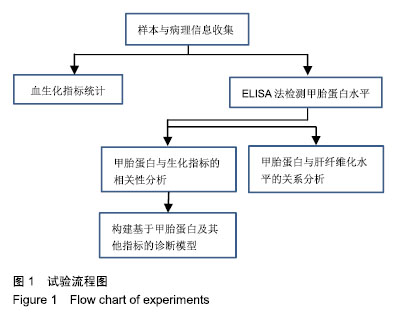
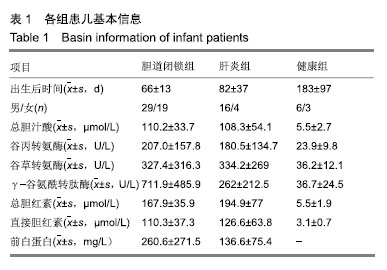
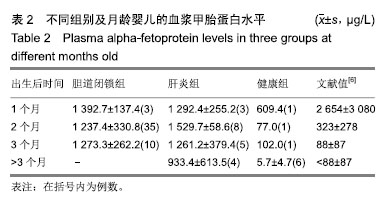
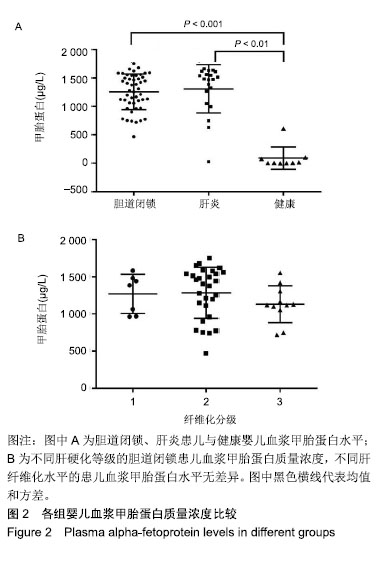
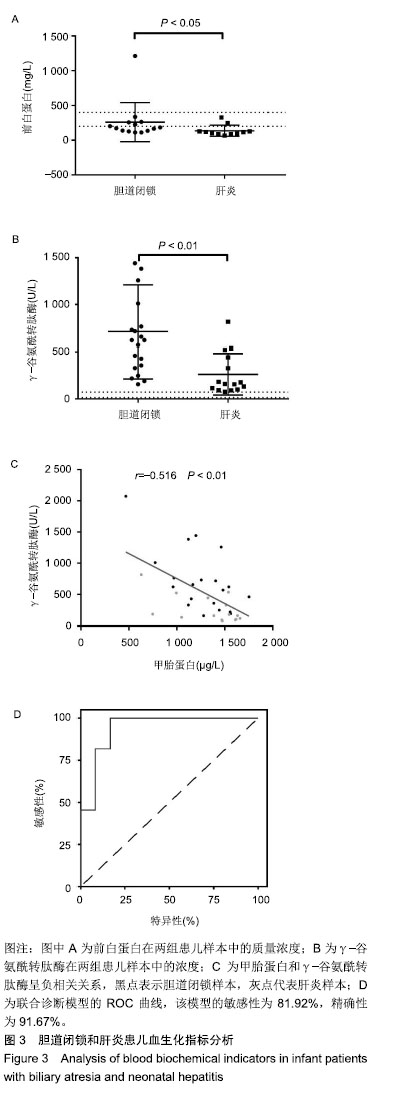
.jpg) 文题释义:
胆道闭锁:是一种严重的新生儿肝胆外科疾病,特征为肝内或肝外胆管闭塞引发的黄疸和进行性肝纤维化,早期诊断和治疗对该病患儿的意义重大。但该疾病在病理特征上与新生儿肝炎相类似,目前只能通过腹腔探查等手术手段最终确诊,这些方法操作复杂且对患儿伤害较大,不适合早期诊断。因此寻找简单有效的生物标志物是胆道闭锁研究的重要内容。
甲胎蛋白:由肝脏合成,是血浆白蛋白的胎儿形式,在胎儿及新生儿血浆中含量丰富,在出生后1年内迅速下降至成人水平。甲胎蛋白的表达与肝细胞增殖或肝损伤后的再生过程有关,肝癌或其他类型的肝损伤将导致甲胎蛋白的表达量升高。
文题释义:
胆道闭锁:是一种严重的新生儿肝胆外科疾病,特征为肝内或肝外胆管闭塞引发的黄疸和进行性肝纤维化,早期诊断和治疗对该病患儿的意义重大。但该疾病在病理特征上与新生儿肝炎相类似,目前只能通过腹腔探查等手术手段最终确诊,这些方法操作复杂且对患儿伤害较大,不适合早期诊断。因此寻找简单有效的生物标志物是胆道闭锁研究的重要内容。
甲胎蛋白:由肝脏合成,是血浆白蛋白的胎儿形式,在胎儿及新生儿血浆中含量丰富,在出生后1年内迅速下降至成人水平。甲胎蛋白的表达与肝细胞增殖或肝损伤后的再生过程有关,肝癌或其他类型的肝损伤将导致甲胎蛋白的表达量升高。